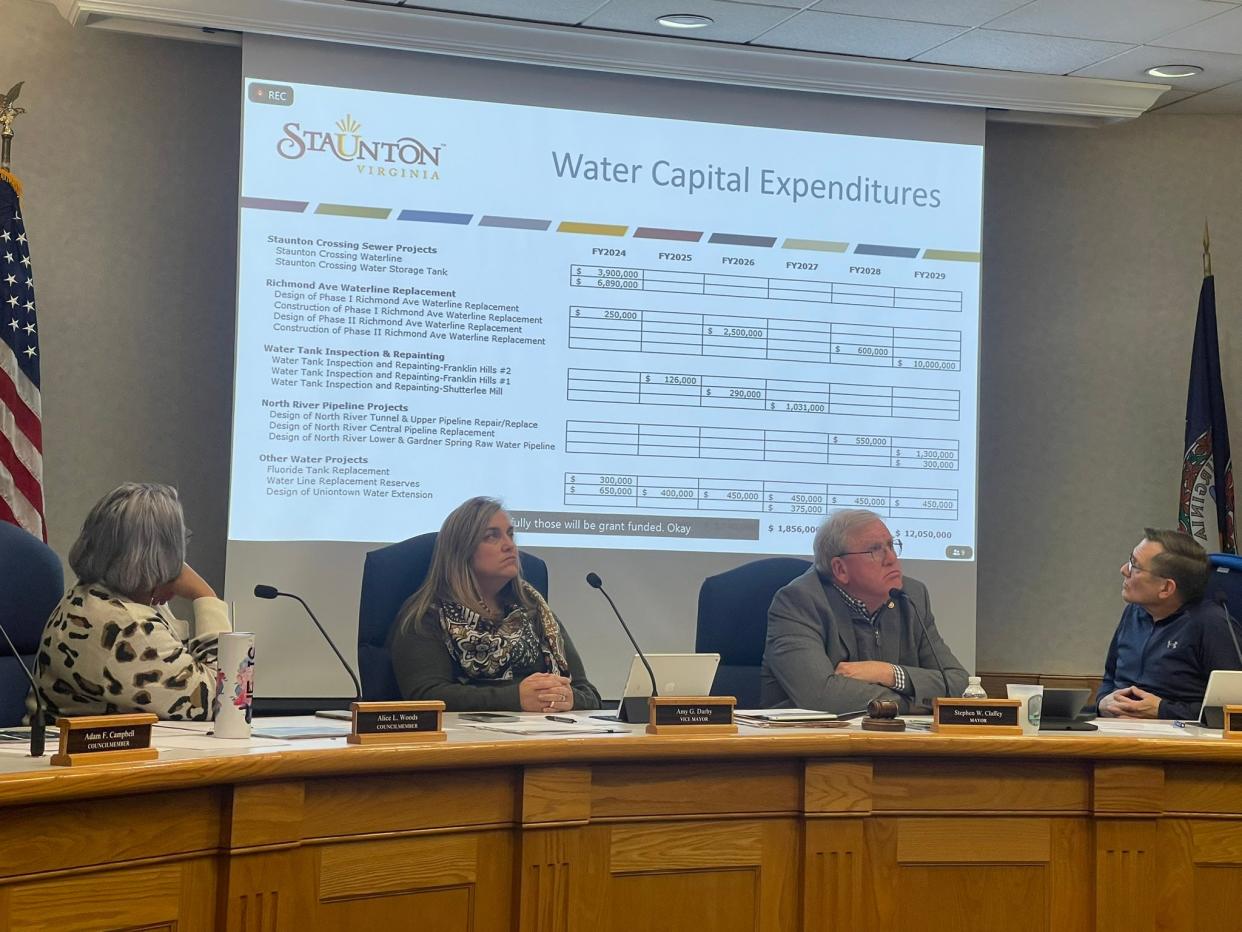Staunton water and sewer budgets operating at a deficit: Could this mean a rate increase?

STAUNTON – Water and sewer rate increases could be coming to Staunton.
No motion or draft rates were presented to Staunton City Council during its Thursday work session, but both the water and sewer finances were presented by Chief Financial Officer Jessie Moyers.
“I was dreading this,” Moyers told the councilmembers. “I don’t want to be the bearer of bad news, but I also want our water funds and sewer funds to survive, be healthy.”
What are the breakeven points?
In order to fully fund the capital improvement projects (CIP) fund and the operating fund for the water system, Moyers said, “It’s an 18% increase per year for each of the next five years, which is not doable.” Staunton’s current water rate is $3.86 per hundred cubic feet (HCL), which is about 748 gallons. There is no service charge.
Water isn’t the only system in trouble though – the sewer system is in worse shape.
“Sewer is going to require a larger increase because it’s not funding itself, it’s operations, for one,” Moyers said. “It’s a large deficit with the CIP.” After Mayor Claffey asked how the city could get to a breakeven point, Moyers elaborated, “You would have to increase 15 percent each year for five years.”
The sewer rate is $4.88/HCL, coming to $68.32 for the typical 14 HCL. Unlike with water, there is a sewer facility fee. The fee’s account totals $4.5 million, a safety net against the deficit. Moyers referred this account, saying, “In order to stick with something that’s affordable for our customers, we need to use those facility fees to bridge the gap and the CIP.”
The last sewer rate increase was in 2012
The sewer rate was last raised in 2012, according to Moyers presentation. The 2013 operating budget, $954,363, has doubled over the past ten years, coming to $2,203,397 in the expected 2025 budget.
There is a nearly $1.7 million sewer fund deficit in the coming year.
“Sewer, I think, is worse off because the operating revenues are not covering the operating expenses and the debt service at this point,” Moyers said. “It’s very concerning, and that’s before you get to any capital expenditures.”
The capital expenses over the next five years total over $12 million, including the installation or repairs to sewer systems in or on Staunton Crossing, Commerce Road, Lewis Creek, Cole Avenue, Wayne Avenue, New Hope Road, and more. Only the design phase of the Uniontown expansion is accounted for in the data.
“Currently, for FY2025 capital, we have a $3 million shortfall. The majority of that is the Crossing Lane Sewer,” Moyers said. “We don’t have enough on balance to cover it at this point.”
Staunton Crossing’s water and sewer projects could be combined and rebid to get a better price on both, Moyers said.
Water looks better, but not good
“The last time we raised our water rate was about four years ago,” Moyers explained. “During that time, inflation has been about 18.4%. It’s getting harder and harder to keep up with the operating costs and capital costs.”
When the rates were last raised four years ago, the water treatment plant budget ran $472,000. This year, the budget was $1.1 million. The city hired five new staff for the plant in the past three years, a supervisor and four new operator positions, with Moyers citing legal operating requirements. Three more positions are on a hiring hold.
“The reason we have trouble filling that is it's hard work for $16.86 an hour when there are warehouse jobs that are climate controlled for $20, $25 an hour,” Moyers said. “These are the jobs that are in the ground, fixing the pipe, cold weather, 2 a.m. Worst case, it's sewer pipe. It’s not pleasant work. It’s hard to remain competitive with the pay rates.”
Infrastructure projects are also a factor, with estimated capital expenditures for the next five years totaling over $30 million for the Staunton Crossing waterline and tank, Richmond Avenue waterline replacement, North River tunnel and pipeline work, replacing a fluoride tank, and the Uniontown expansion design. It also does not include construction on the Uniontown expansion.
A 20-cent raise would bring in $175,000 of additional revenue. Moyers said, “On a minimum bill, it’s a dollar every two months. It’s a couple of dollars for 14 HCL, which is typical for a family.” According to Moyers’ presentation, Waynesboro’s water rate is $4.38/HCL and Augusta County’s is $4.80/HCL, both with a flat amount service charge of $19.70 and $15.24, respectively.
What happens next?
The council was mostly quiet after the presentation until Mayor Claffey jokingly thanked Moyers for the “uplifting” presentation. After the joke, Claffey then continued on to say, “When you don’t raise a rate from 2013 until now, you’re going to put yourself in a position like this. We have to understand, taxes are meant to be competitive and not to be ignored. We’re providing services and we have to raise taxes to make sure we’re not so out of wack.”
“It would have been nice to keep up with inflation,” Councilmember Brad Arrowood added.
The presentation listed a possible timeline for rate increases, including a proposed ordinance introduction on March 28, a public hearing on April 11, and a council vote on April 25. However, Moyers said, “We don’t really have recommendations on here, we’re just giving you information at this point.”
Moyer’s presentation PowerPoint is available online.
Lyra Bordelon (she/her) is the public transparency and justice reporter at The News Leader. Do you have a story tip or feedback? It’s welcome through email to lbordelon@gannett.com. Subscribe to us at newsleader.com.
More: Police say nearly $60,000 stolen from Staunton man, suspect extradited from Texas
More: 30th annual Virginia Festival of the Book comes to Staunton
This article originally appeared on Staunton News Leader: Staunton water and sewer budgets operating at a deficit: Could this mean a rate increase?

